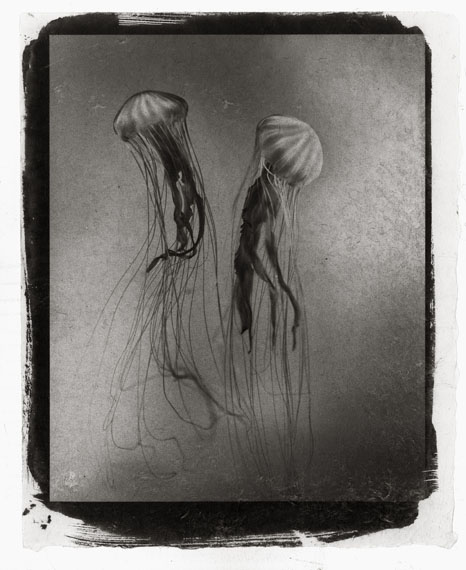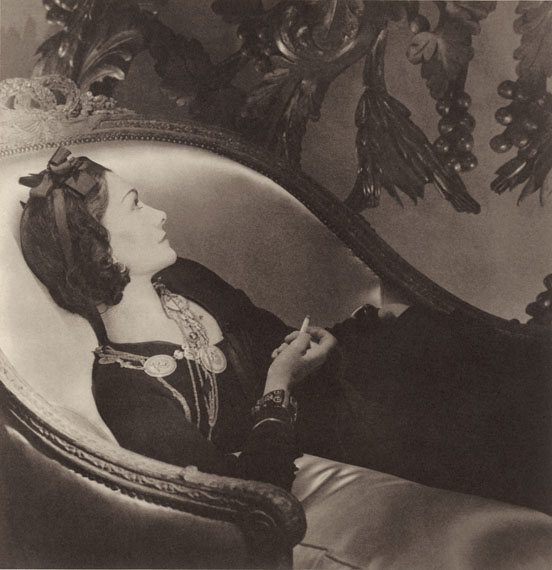
Jellyfish II
Platinum Palladium Print
© Gregor Törzs / Courtesy of Bernheimer Fine Art
THE ART OF PLATINUM PRINTING
Nick Brandt » Brigitte Carnochan » Sebastian Copeland » Horst P. Horst » Douglas Kirkland » Len Prince » Gregor Törzs »
Exhibition: 16 May – 12 Jul 2014
Thu 15 May 17:00 - 20:00

Bernheimer Fine Art
6045 Meggen
+41 (0)41-2405050
contact@bernheimer.ch
www.bernheimer.ch
Wed-Fri 12-18, Sat 10-16

Ford Model V, New York City, 1991
Platinum/palladium print
© Len Prince / Courtesy of Bernheimer Fine Art
THE ART OF PLATINUM PRINTING
FRIDAY 16 MAY 2014 – SATURDAY 12 JULY 2014
The exhibition will be launched on 15 May from 5 pm to 8 pm at the gallery in Lucerne, Haldenstrasse 11, in the presence of some presented artists.
Bernheimer Fine Art is pleased to announce an exhibition of museum quality taking place from 16 May to 12 July, 2014 at the gallery in Lucerne, Haldenstrasse 11. The group exhibition THE ART OF PLATINUM PRINTING is a continuation and extension of the highly successful exhibition staged by Bernheimer Fine Art Photography in Munich in autumn 2013. Platinum prints offer the ultimate in photographic permanence coupled with a subtle tonal range and a tactile quality of the image made on handmade paper. This exhibition presents finest examples of the works by photographers such as Horst P. Horst, Sebastian Copeland, Douglas Kirkland, Len Prince and Gregor Törzs.
Platinum prints are loved by photographers and treasured by collectors and investors because of their special tones, the surface quality and their permanence. The unique beauty of a fine platinum print involves a broad scale of tones from black to white. The delicate, rich platinum tones range from warm black, to reddish brown, to expanded mid tone greys that are unobtainable in silver prints. In the deepest shadows the platinum print still presents information; the depth of the image is alive and three-dimensional. Platinum prints are not only exceptionally beautiful, they are the most durable of all photographic processes. The platinum metals are more stable than gold, and it is estimated that a platinum image, properly made, can last thousands of years. The nature of this process provides another distinctiveness, even within a short edition of the same image, each print carries diverse subtleties making it a unique interpretation in itself. This handcrafted printing process is far removed from the world of mass produced silver-based papers and modern supports for digital outputs. In platinum printing there is no reliance of factory prepared materials, each print of an edition being executed individually as though is was the only example of that image, an unrepeatable dialogue between the image, the chemistry and the printer's skill.
Invented by William Willis in 1876 the process became popular during the 19th century; the Pictorialists, a group of photographers active primarily between the years 1880 to 1920, worked using the Platinum process extensively because of its delicacy and its potential for expressing the characteristics of more traditional art making methods such as drawing and etching. The process virtually disappeared during World War I when platinum was diverted to the war effort - the cost became prohibitive. Due to its ease of manufacturing, availability and cost, silver became the dominant light sensitive material, a fact that continues to this day.
Since the early 1960s, American photographer Irving Penn made a limited number of platinum prints of his most celebrated photographs. A meticulous craftsman, Penn experimented extensively to make prints with remarkably subtle, rich tonal ranges and luxurious textures. Through his work the Platinum printing process became popular once more. A number of artists followed his example to present some of their most iconic images.
In particular the fashion photographers enjoyed the richness of Platinum prints, Horst P.Horst selected his most iconic images and chose the platinum printing process to give these images a significantly wider range of tones and a luxurious matte surface. A small selection of these valuable prints by Horst P. Horst coming directly from the artist´s estate will form the highlight of the exhibition at Bernheimer. Some of these photographs have never been on display before and will be shown at Bernheimer in Lucerne for the first time. In autumn 2014 the Victoria and Albert Museum in London dedicates a large retrospective to the fashion photography icon.
The making of a Platinum print is an art form in itself. Most of the photographers who choose to have their pictures printed in this method select only their most treasured, valued and loved images to be presented in this way. Only very few masters remain worldwide capable of printing in this highly delicate and elaborate manner. Bernheimer Fine Art Photography will exhibit prints of the most renown printing experts from London and New York specially made for their exhibition.
There are also a few younger artists who have been interested in the Platinum printing process, deliberately turning away from the digital outputs of our times and making this handmade process part of their art work.
Gregor Toerzs, one of the young talents represented by Bernheimer, has turned his studio in Berlin into a laboratory to specialise in this printing technique. The photographer personally platinum prints each photograph in his own studio and he considers the printing process, as well as choosing the matching distinctive paper, part of his art. Playing with our viewing habits and by experimenting with different papers and negatives he achieves every time a new aesthetic dimension.
Among others the exhibition showcases for the first time Platinum prints by the British/ American photographer, adventurer and environmentalist Sebastian Copeland, who took photographs of his expeditions through the Arctic, Antarctic and Greenland. He captures unique sceneries, in which the mystical atmosphere of the landscapes is even more emphasized by the Platinum printing technique.
All of these photographers aim to not only take a good picture, but to make their most valued pictures into a precious print and thus highlight the ornate aesthetic of their art works.�

Iceberg XVII, Greenland, 2010
Platinum Contact Print
© Sebastian Copeland / Courtesy of Bernheimer Fine Art
THE ART OF PLATINUM PRINTING
16. Mai 2014 bis 12. Juli 2014
Die Vernissage zur Ausstellung findet am 15. Mai von 17:00 Uhr bis 20:00 Uhr in der Galerie in der Haldenstrasse 11 in Anwesenheit einzelner gezeigter Künstler statt.
Vom 16. Mai 2014 bis 12. Juli 2014 zeigt Bernheimer Fine Art in der Haldenstrasse 11 in Luzern eine Gruppenausstellung von musealer Qualität. Diese Ausstellung ist eine Fortsetzung und Ergänzung zu der im Herbst 2013 in München präsentierten, sehr erfolgreichen Gruppenausstellung „Platinum“. Gezeigt werden herausragende Photographiekünstler des 20. und 21. Jahrhunderts, deren Werke in der speziellen Technik der Platinum-Handabzüge gefertigt wurden. Zu sehen sind u.a. Arbeiten von Horst P. Horst, Sebastian Copeland, Douglas Kirkland, Len Prince und Gregor Törzs.
Ein Platinum-Abzug unterscheidet sich wesentlich von anderen schwarz-weiß Handabzügen: Zunächst ist die Beständigkeit der Abzüge im Vergleich mit allen anderen Arbeiten auf Papier unerreicht. Ein solcher Abzug verliert mit der Zeit nicht an Intensität und nimmt auch dauerhaft keinen Schaden durch das Einwirken von Licht. Die Chemikalien werden für einen Platinum-Abzug mit einem Pinsel in ein handgeschöpftes Papier eingearbeitet und liegen nicht, wie bei herkömmlichen schwarz-weiß Bildern, in einer Emulsion auf dem Papier auf. Das Papier wird für jeden einzelnen Abzug mit größtem Aufwand von Hand bearbeitet. Das heißt auch, dass ein solcher Abzug einen Unikatcharakter erhält, selbst wenn von einem Negativ mehrere Bilder gemacht werden. Auch in einer Edition trägt jeder einzelne Abzug gewisse unterschiedliche Feinheiten, denn ein so aufwändig hergestellter Handabzug kann niemals mit einem anderen identisch sein. Zudem ist die Tonalität in den Grauabstufungen eines Platinum Abzugs im Vergleich zu einem Silbergelatine-Abzug um ein vielfaches reicher; die Graustufen sind so fein, dass selbst in dunklen Bereichen noch eine Zeichnung erkennbar ist.
Gerade im Zeitalter der digitalen Photographie werden diese Merkmale der Platinum-Abzüge bei Kennern und Sammlern aufs Höchste geschätzt.
Das Verfahren der Platin-Abzüge wurde 1873 von William Willis entwickelt und war für viele der bekanntesten Photographen des 19. Jahrhunderts lange Zeit die beliebteste Art ihre Bilder zu entwickeln. Platin war jedoch sehr teuer und später kaum noch zu bekommen, da es zur Zeit des 1. Weltkrieges nur noch für die Herstellung von Waffen gebraucht werden durfte. Bald wurde diese Technik von günstigeren und weniger zeitaufwändigen Verfahren ersetzt und geriet immer mehr in Vergessenheit.
Erst in den 1960er Jahren wurde Irving Penn auf die Methode der Platinum-Abzüge aufmerksam und erlernte anhand alter Aufzeichnungen von William Willis den Prozess autodidaktisch. Er war fasziniert von der unvergleichlichen Qualität, ästhetischen Schönheit und Besonderheit der Ergebnisse dieser Arbeit und machte diese wieder populär.
Seinem Beispiel folgend, veredelten einige der großen Modephotographen des 20. Jahrhunderts ihre herausragenden Arbeiten in dieser speziellen Technik.
Horst P. Horst, der Doyen der Modephotographie, wählte seine bekanntesten Bilder aus und ließ diese in Platin entwickeln, um ausgewählten Motiven einen neuen Kunstcharakter zu verliehen.
Im Herbst 2014 wird Horst P. Horst mit einer großen Retrospektive im Viktoria and Albert Museum, London, geehrt. Eine kleine Gruppe seiner Werke in Platinum bilden einen Glanzpunkt der Ausstellung bei Bernheimer. Diese Abzüge kommen direkt aus dem Nachlass des Künstlers und sind teils noch nie zu vor gezeigt worden.
Die Herstellung von Platinum-Abzügen ist eine eigene Kunst und wird von den Photographen meist für ihre besonderen, ihre besten oder liebsten Bilder gewählt, wie ein Schmuckstück, das man veredelt. Es weltweit nur noch sehr wenige Photolabore, die dieses aufwändige Verfahren noch beherrschen und für einige wenige Künstler arbeiten.
In den letzten Jahren haben sich auch ein paar junge Künstler von dieser besonderen Technik inspirieren lassen und die Fähigkeiten der Herstellung von Platinum Abzüge selbst erlernt, um sich ganz bewusst mit dieser Handarbeit dieser Photographietechnik von den digitalen Medien abzuwenden und abzusetzen.
In der Ausstellung werden u.a. erstmals gezeigte Platinum-Werke des in England geboren Photographen, Abenteurer und Umweltschützers Sebastian Copeland gezeigt. Sebastian Copeland photographierte auf seinen Expeditionen durch die Arktis, Antarktis und Grönland einzigartige Motive, die durch den Platinum Druck die mystische Atmosphäre dieser Landschaften noch vertiefen.
Der Künstler Gregor Törzs, der zur Ausstellungseröffnung anwesend sein wird, hat sich in seinem Berliner Studio auf diese Technik spezialisiert, die er ebenso wie das jeweilige Papier, das er für seine Arbeiten wählt, als einen ganz wesentlichen Teil seiner Kunst versteht. Er liebt es mit unseren Sehgewohnheiten zu spielen und experimentiert mit unterschiedlichen Papieren und Negativen um immer wieder eine ganz neue Ästhetik zu erzielen.
All diesen Photographen geht es nicht nur darum, ein gutes Motiv aufzunehmen, sondern Sie veredeln durch diesen Prozess der Platinum-Abzüge ihre eindrucksvollsten Bilder. Platinum stellt in besonderem Maße die künstlerischen Aspekte der Motive in den Vordergrund und bewahrt sie für die Ewigkeit.
In der Galerie Bernheimer in Luzern werden Platinum-Bilder von Nick Brandt, Brigitte Carnochan, Sebastian Copeland, Horst P. Horst, Douglas Kirkland, Len Prince und Gregor Törzs gezeigt. �

Coco Chanel, reclining
Platinum Palladium Print
© Horst P. Horst / Courtesy of Bernheimer Fine Art